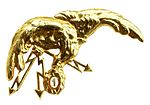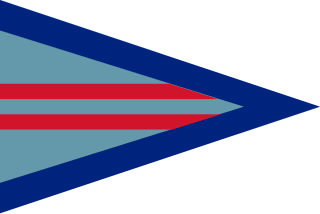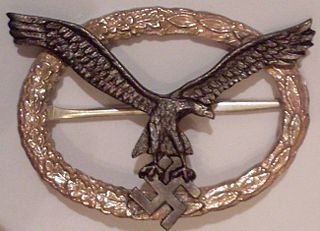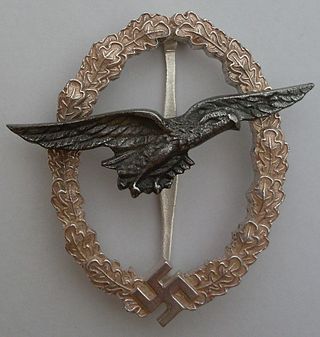Belgium

The current aviator badge of the Belgian Air Force depicting the Leo Belgicus and surmounted the Royal Crown of Belgium.
An aviator badge is an insignia used in most of the world's militaries to designate those who have received training and qualification in military aviation. Also known as a pilot's badge, or pilot wings, the aviator badge was first conceived to recognize the training that military aviators receive, as well as provide a means to outwardly differentiate between military pilots and the “foot soldiers” of the regular ground forces.

The current aviator badge of the Belgian Air Force depicting the Leo Belgicus and surmounted the Royal Crown of Belgium.

Aviator badge of the Bangladesh Air Force [1]
The Aviator Badge of Bangladesh Air Force closely resembles the pilots flying badge of The Royal Air Force. Though the badge has a touch of its own characteristics.
The Pilot Flying Badge of the Royal Canadian Air Force is:

The emblem of the People's Liberation Army Air Force is:


The aviator badge of the Royal Danish Air Force is based on the national coat of arms of Denmark.
The aviator badges of the French Air Force/Armée de l'air française and French Navy/Force maritime de l'aéronautique navale are:
Several badges were donated to German aircrew prior, during or after the First World War. The most notable were: [2] [3]
The Military Pilot Badge was donated on January 27, 1913 by Emperor Wilhelm II. It could be awarded to officers, NCOs and crews who, after completing the two required tests for pilots and after completing their training at a military air base, acquired the certificate as a military pilot issued by the military air and land transportation inspection (Inspektion des Militär-Luft- und Kraft-Fahrtwesens). A similar badge for military pilots was donated on 4 February 1913 by Prince Ludwig from Bavaria.
The badge for navy pilots on seaplanes (Abzeichen für Marine Flugzeugführer auf Seeflugzeugen) was donated on 31 May 1913 by King and Emperor Wilhelm II, for all officers and soldiers, who successfully completed the training on a naval aircraft station and thus received a certificate of qualification as a naval pilot.
The badge for navy pilots on land planes (Abzeichen für Marine Flugzeugführer auf Landflugzeugen) was donated on 23 February 1915 by emperor Wilhelm II for pilots of the Navy, who completed their service in the war on land planes.
The badge for observation officers from airplanes (Abzeichen für Beobachtungsoffiziere aus Flugzeugen) was donated on January 27, 1914 by emperor Wilhelm II. Prerequisites for the award were: 1. a distance traveled of at least 1000 km in an aircraft, 2. a successfully completed technical assistance examination on an aircraft, 3. pass of at least one retake, 4. accomplished exploration missions, and 5. a certification as an observation officer. A similar badge was donated by King Ludwig III. on 3 March 1914 for the Bavarian army.
The airgunner badge (Abzeichen Flugzeug-Fliegerschützen) was founded on January 27, 1918 by emperor Wilhelm II. The soldiers had to demonstrate in-depth knowledge in engine construction and operation, in flight training, in map reading, in the tactics of aerial combat, in theory of bombing, and skills in the operation of machine guns on the ground and in aerial combat.
The commemorative badge for airship crews (Erinnerungsabzeichen für Besatzungen der Luftschiffe) was donated in 1920 by Reichswehr Minister Otto Gessler. There were two versions for Army and Navy airships. Upon request, it was awarded to officers, deck officers, NCOs and crews of former airship crews, who during the war had at least one year of activity on front aircraft.

The Pilotenabzeichen (Pilot's Badge) of the former Luftwaffe had been instituted by Hermann Göring on 12 August 1935. It came in distinct types; nickel silver (changed to zinc during the war) and a variant made of gold. [4] It depicts a silver eagle perched atop a swastika, wings open in a landing pose, and surrounded by a wreath with laurel on the right side and oak branches on the left side, respectively. [5] It was worn in the center of the left breast pocket of the service tunic, underneath the Iron Cross 1st Class if awarded. [6] The badge was awarded after one completed flight training and the flying licence and citation were received. [5]

In the Bundeswehr the aviation badge (Tätigkeitsabzeichen Militärluftfahrzeugführer) comes in three grades: bronze (Standard Pilot), silver (Senior Pilot) after 1200 flight hours and gold (Command Pilot) after 1800 flight hours. It depicts the Bundesadler surrounded by an oak leaf wreath between two wings. It is worn above the right breast pocket. A total of two Tätigkeitsabzeichen may be worn, one of which can be foreign in which case the foreign one would be worn below the German one. [7]
Pilots and navigators of the Royal Hungarian Air Force wore their aviator rating badge sewn on their uniforms right breast above the pocketflap. The Observers Badge was the same, except without the Holy Crown of Hungary. A smaller version of the pilot's badge which was worn on the lower left sleeve of the overcoat - observers also worn a small insignia without the crown on their sleeve. [8] During World War II a gilded bronze pilot and observer badge was also introduced.
 |  |  |
After the withdrawal of Soviet forces from Hungary a new Hungarian Air Force was created. It took on the traditions of the Royal Hungarian Air Force. There are 4 classes of pilots badges. Gold laurel 1st class aviator; 1st class aviator, 2nd class aviator, and 3rd class aviator.

 |  |  |
The current aviator badges ("wings") in the Israel Air Force is:
The aviator badge of the Namibian Air Force is ...
The aviator badge of the Royal Netherlands Air Force and the Royal Netherlands Navy is

The current aviator badge of the Polish Air Force has been in use since the 1920s. The badge is called gapa and represents silver eagle in flight with gold laurel wreath in the bill. Navigator/Observer badge (below) represents the same eagle, but in gold with added lightning bolts. The gapa is worn in the usual place on the upper left breast above the pocket, but unlike other air forces it is suspended on a chain. It adorned the uniform of Polish Air Force officers in the RAF during World War II along with their RAF wings. In the combat version (for at least 7 flights in combat conditions) the badge has a green laurel wreath.
| Badge | Pilot | Observer | |||||
|---|---|---|---|---|---|---|---|
 Air Forces |  |  | |||||
| Pilot | Observer | ||||||
| Abbreviation | pil. | obs. | |||||
The current aviator badge of the South African Air Force has been in use since 2002, when South Africa adopted a new coat of arms. Like the RAF, the SAAF also has a half-wing version of the badge, in this case for navigators. The aviator and navigator badges comes in three grades: bronze, silver and gold. Reserve force aviator badges have a light blue inlay around the coat of arms as appose to the dark blue of permanent air force aviators.

The current aviator badge of the Royal Air Force has been in use since the Second World War. The badge consists of a winged crown and wreath, beneath which are the letters "RAF". The Royal Air Force also uses a "half wing" version to denote Weapon System Officers (WSOs) and Weapon System Operators (WSOps) as well as various airborne roles such as Airborne Technician.

A Military Aviator badge existed from 1912-17 before being replaced by the predecessor of the "wings" badge.

A United States Aviator Badge refers to three types of aviation badges issued by the United States Armed Forces, those being for Air Force, Army, and Naval (to include Marine and Coast Guard) aviation.
Air Force Pilot and Army Aviator Badges are issued in three ratings: Basic, Senior, and Command (Air Force)/Master (Army). The higher degrees are denoted by a star or star with wreath above the badge. Air Force regulations state that the basic rating denotes completion of specified training and that the advanced ratings denote experience levels. The Naval Aviator Badge is issued to pilots upon designation as a Naval Aviator for Navy, Marine Corps, and Coast Guard aviators who successfully complete flight training. There is a single badge design regardless of an individual’s further qualifications.
A flight surgeon is a military medical officer practicing in the clinical field of aviation medicine. Although the term "flight surgery" is considered improper by purists, it may occasionally be encountered.

Wing commander is a senior commissioned rank in the British Royal Air Force and air forces of many countries which have historical British influence, including many Commonwealth countries but not including Canada and South Africa. It is sometimes used as the English translation of an equivalent rank in countries which have a non-English air force-specific rank structure. It ranks immediately above squadron leader and immediately below group captain.

The United States Astronaut Badge is a badge of the United States, awarded to military and civilian personnel who have completed training and performed a successful spaceflight. A variation of the astronaut badge is also issued to civilians who are employed with the National Aeronautics and Space Administration as specialists on spaceflight missions. It is the least-awarded qualification badge of the United States military.
The Flight Meteorologist insignia is a military badge decoration of the United States Navy which is issued to officers of the Restricted Line who are commissioned as weather and meteorology specialists. To be issued the insignia, an officer must also have completed flight training to qualify as a Naval Aircrew Member. The insignia itself is very similar to the Naval Aircrew Badge.
The Observer Badge is a military badge of the United States armed forces dating from the First World War. The badge was issued to co-pilots, navigators, and flight support personnel who had received a variation in the training required for the standard Pilot's Badge. The Observer Badge survived through the Second World War and into the 1950s, at which time the concept of an Observer Badge was phased out in favor of the modern Aircrew Badge and Navigator-Observer Badges. In addition to wings for Naval Aviators and Naval Flight Officers, the United States Navy still maintains an "Observer Badge" which is issued to flight-qualified mission specialists, such as a select number of meteorologists and intelligence officers in both the U.S. Navy and U.S. Marine Corps. The U.S. Air Force awards its USAF Observer Badge, which is identical to the USAF Navigator Badge, to Air Force officers who have qualified as NASA Space Shuttle Mission Specialists, have flown an actual mission aboard the shuttle and/or the International Space Station and who are otherwise not previously aeronautically rated as an Air Force pilot or navigator.

A United States Aviator Badge refers to three types of aviation badges issued by the United States Armed Forces, those being for Air Force, Army, and Naval aviation.
The Navigator Badge is a military qualification badge of the United States Air Force which was first created during the Second World War. The current USAF badge is designated by Air Force Instructions as the Navigator/Observer Badge and is issued to rated officers in both rating categories. In 2009, it was renamed as the Combat Systems Officer badge.
The Flight Surgeon Badge is a military badge of the United States Armed Forces which has existed to designate Flight Surgeons since the Second World War.

Insignia and badges of the United States Marine Corps are military "badges" issued by the United States Department of the Navy to Marines who achieve certain qualifications and accomplishments while serving on both active and reserve duty in the United States Marine Corps.

An aircrew flying badge is the badge worn on the left breast, above any medal ribbons, by qualified aircrew in the Royal Air Force, Royal Navy, British Army, Indian Air Force, Pakistan Air Force, Royal Canadian Air Force, Royal Australian Navy, Australian Army, Royal Australian Air Force, Royal New Zealand Air Force, South African Air Force and Sri Lanka Air Force. An example of a real pilot brevet is as opposite:
The Aircrew Badge, commonly known as Wings, is a qualification badge of the United States military that is awarded by all five branches of armed services to personnel who serve as aircrew members on board military aircraft. The badge is intended to recognize the training and qualifications required by aircrew of military aircraft. In order to qualify as an aircrew member and receive the Aircrew Badge, such personnel typically undergo advanced training in aircraft in-flight support roles.

A naval aviator is a commissioned officer or warrant officer qualified as a crewed aircraft pilot in the United States Navy or United States Marine Corps. United States Coast Guard crewed aircraft pilots are officially designated as "Coast Guard aviators", although they complete the same undergraduate flight training as Navy and Marine Corps crewed aircraft pilots, and are awarded the same aviation breast insignia.

U.S. Air Force aeronautical ratings are military aviation skill standards established and awarded by the United States Air Force for commissioned officers participating in "regular and frequent flight", either aerially or in space, in performance of their duties. USAF aeronautical badges, commonly referred to as "wings" from their shape and their historical legacy, are awarded by the Air Force in recognition of degrees of achievement and experience. Officers earning these badges and maintaining their requirements are classified as rated officers and receive additional pay and allowances.

The Royal Air Force uniform is the standardised military dress worn by members of the Royal Air Force. The predominant colours of Royal Air Force uniforms are blue-grey and Wedgwood blue. Many Commonwealth air forces' uniforms are also based on the RAF pattern, but with nationality shoulder flashes. The Royal Air Force Air Cadets wear similar uniforms.

The Aircrew Badge was a German military decoration awarded to members of the German Air Sports Association, an organisation set up by the Nazi Party in March 1933 to establish a uniform basis for the training of military pilots. The German Air Sports Association was a cover organization for the future German Air Force (Luftwaffe). Its chairman was the future Commander in Chief of the Luftwaffe Hermann Göring and its vice-chairman Ernst Röhm. Since the Treaty of Versailles officially forbade Germany from building fighter planes of any sort, the German Air Sports Association used gliders to train men who were still officially civilians for the future Luftwaffe. It was the first qualification badge recognized by the Luftwaffe.

The Radio Operator & Air Gunner's Badge is a commonly accepted title for the Luftwaffen-Fliegerschützen-Bordfunker-und Bordmechanikerabzeichen. It was a German military decoration awarded to radio operators, air gunners and mechanics who were members of the German Air Force (Luftwaffe) after they completed two months training or had taken part in at least five operational flights. If wounded during an operational flight, the badge could be awarded and worn earlier. Later in June 1942, a separate badge was introduced for air gunners and flight engineers. That badge had the same qualifications.

The Air Gunner's and Flight Engineer's badge was a German military decoration awarded to air gunners, mechanics or aircrew meteorologists who were members of the German Air Force (Luftwaffe) after they completed two months training or had taken part in at least five operational flights. If one was wounded during an operational flight, the badge could be awarded earlier. For Luftwaffe members who were air gunners and mechanics this badge replaced an earlier separate badge which had been introduced back in 1935. The qualifications for the two badges were the same for recipients.

The Glider Pilot's Badge was a German military decoration that was awarded during World War II to military pilot's who were members of the German Air Force (Luftwaffe) after they completed their glider training. Honorably discharged personnel who met the requirements could also be awarded the badge. A citation was issued with the awarded badge. It was worn on or right below the left breast tunic pocket.

The Observer's Badge was a German military decoration that was awarded before and during World War II to members of the German Air Force (Luftwaffe). They qualified for the badge after completing two months of qualifying service and five operational flights in the role of observer, navigator or bombardier; also, it could be awarded after a member of the German Air Force was wounded while acting in the capacity of an observer during a qualifying flight. It was worn on the left breast tunic pocket of an air force or political uniform tunic. A citation was issued with the awarded badge. Thereafter, Luftwaffe service personnel who had already been awarded the Pilot's Badge and Observer's Badge could qualify for the Pilot/Observer Badge. After 31 July 1944 the regulations were changed and the recipient had to have held both qualification certificates for at least one year to qualify for the Pilot/Observer Badge.
The Royal Prussian Military Pilot's Badge was created by Kaiser Wilhelm II on January 27, 1913. It could be awarded to officers, non-commissioned officers and men who, after passing the two mandatory examinations for pilots and after completing their training at a military pilot station, acquired the certificate of competency as a military pilot.